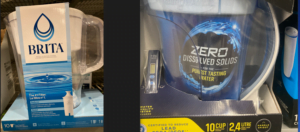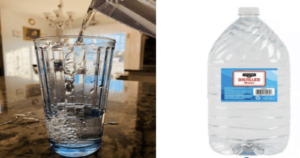Hey there! Have you ever thought about the differences between filtered water and tap water?
In the quest for clean and safe drinking water, two contenders often take center stage: filtered water and tap water. Both sources play vital roles in quenching our thirst and sustaining our daily lives, yet they come with distinct characteristics and considerations. Tap water, the readily available resource delivered straight to our homes, undergoes extensive treatment processes before it reaches our faucets.
Filtered water, on the other hand, undergoes an additional purification step, typically through specialized systems or portable devices, to remove specific contaminants or improve taste. The choice between the two hinges on factors ranging from convenience and cost to health considerations and environmental impact. As we delve deeper into the nuances of filter water versus tap water, it becomes evident that the decision is not one-size-fits-all, but rather a nuanced choice that hinges on individual preferences and priorities.

Filter Water
Filtered water refers to water that has undergone a process of purification to remove impurities, contaminants, and particles. This process typically involves the use of a filtration system, which can be a physical barrier or a chemical process, to ensure that the water is safe and clean for consumption.
Types of water filter
There are various types of filters available, each designed to target specific types of contaminants. Some common types of water filters include:
Active Carbon Filter
These filters use activated carbon, which has a large surface area and is highly porous. They are effective at removing organic compounds, chlorine, and some heavy metals from water. They are commonly used in household pitcher-style filters and faucet-mounted systems.
- Adsorption of Contaminants: Activated carbon is highly effective at adsorbing a wide range of organic compounds, chemicals, and contaminants from liquids and gases. This includes substances like chlorine, volatile organic compounds (VOCs), pesticides, pharmaceuticals, and certain heavy metals.
- Improved Water Quality: Activated carbon is commonly used in water filtration systems to improve the taste, odor, and clarity of water. It can remove undesirable tastes and odors caused by chlorine, organic matter, and other impurities.
- Removal of Harmful Chemicals: It is particularly effective at removing harmful chemicals, such as trihalomethanes (THMs), which are disinfection byproducts formed when chlorine reacts with organic matter in water.
- Treatment of Contaminated Air: Activated carbon is used in air purification systems to remove volatile organic compounds (VOCs), gases, and odors from indoor air. It is commonly found in air filters and masks.
- Purification of Pharmaceuticals: In the pharmaceutical industry, activated carbon is used to purify drugs and other substances by adsorbing impurities and contaminants.
- Detoxification in Medicine: Activated carbon is administered orally in medical emergencies to treat certain types of poisoning. It works by adsorbing toxins in the digestive tract, preventing them from being absorbed into the bloodstream.
- Environmental Remediation: Activated carbon is used in environmental cleanup efforts to adsorb and remove contaminants from soil and water, particularly in areas affected by industrial pollution or chemical spills.
- Gold Recovery: Activated carbon is used in the gold mining industry to extract gold from cyanide solutions. The porous structure of activated carbon provides a large surface area for gold particles to adhere to.
- Gas Purification: It is used in gas masks and respirators to remove toxic gases and fumes from the air, providing protection for individuals working in hazardous environments.
- Decolorization in Food and Beverage Industry: Activated carbon is used to remove color impurities from certain food and beverage products, such as fruit juices and sugar syrups.
- Improvement of Soil Quality: Activated carbon can be used as a soil amendment to improve soil structure, water retention, and nutrient retention, making it beneficial for agricultural applications.
- Reduction of Greenhouse Gas Emissions: Activated carbon can be used in certain industrial processes to capture and store carbon dioxide, contributing to efforts to combat climate change.
- Overall, activated carbon plays a crucial role in a wide range of industries and applications, providing effective solutions for purification, detoxification, and environmental protection.
Reverse Osmosis (RO) Systems
RO systems use a semi-permeable membrane to remove a wide range of contaminants including minerals, bacteria, viruses, and chemicals. They are highly effective but can be slower and waste more water than other filtration methods.
Benefits of Osmosis System
- Removes Contaminants: RO systems can effectively remove a wide range of contaminants, including bacteria, viruses, dissolved solids, heavy metals, minerals, and chemicals. This makes the water safer and healthier to consume.
- Improved Taste and Odor: The process of reverse osmosis can significantly improve the taste, odor, and appearance of water by removing impurities and dissolved minerals.
- Saves Money: Using an RO system can be cost-effective in the long run. It eliminates the need for buying bottled water, which can be expensive over time.
- Saves Energy: While the process of reverse osmosis does require energy, it’s generally considered more energy-efficient compared to methods like distillation.
- Easy to Maintain: RO systems are relatively easy to maintain. Regular filter changes and basic maintenance can keep the system functioning optimally.
- Environmentally Friendly: By using an RO system, you reduce the need for single-use plastic bottles, which can help reduce plastic waste and its impact on the environment.
- Versatile: RO systems are versatile and can be used for both residential and commercial applications. They can be installed under sinks, in basements, or even in larger-scale industrial settings.
- Customizable: RO systems can be customized to meet specific water quality requirements. Different types of membranes and filters can be selected based on the contaminants present in the water.
- Consistent Quality: Once properly installed, an RO system can provide a consistent and reliable supply of high-quality drinking water.
- Reduces Water Hardness: RO systems are effective at reducing water hardness by removing minerals like calcium and magnesium. This can prevent scaling and buildup in pipes and appliances, potentially extending their lifespan.
- Good for Specialized Applications: RO water is often used in applications where highly purified water is required, such as in aquariums, laboratories, and pharmaceutical production.
- Improves Cooking and Beverage Quality: Because RO water is free from impurities and minerals, it can enhance the flavor of food and beverages, particularly sensitive items like coffee and tea.
- It’s worth noting that while reverse osmosis is highly effective at removing a wide range of contaminants, it may also remove some beneficial minerals from water. In some cases, people choose to remineralize the water after the RO process. Additionally, RO systems do produce a certain amount of wastewater, which should be considered in terms of environmental impact.
UV Filters.
UV filters use ultraviolet light to kill or inactivate bacteria, viruses, and other microorganisms present in water. They are often used in conjunction with other filtration methods for comprehensive water treatment. UV water filters, also known as ultraviolet water purification systems, use ultraviolet light to disinfect water by killing or inactivating harmful microorganisms.
Benefits of using UV water filters:
- Effective Disinfection: UV filters are highly effective at killing a wide range of harmful microorganisms, including bacteria, viruses, and parasites. This makes them an excellent method for ensuring safe drinking water.
- Chemical-Free: Unlike some other water treatment methods, UV filtration does not rely on the use of chemicals, making it a safe and environmentally-friendly option for water purification.
- No Residual Taste or Odor: UV treatment does not alter the taste, color, or odor of the water. It leaves no chemical residue, ensuring that the purified water remains natural and enjoyable to drink.
- Rapid Treatment: UV systems can provide immediate purification of water, as the treatment process is almost instantaneous. There is no need for a holding tank or storage period after treatment.
- Low Maintenance: Once installed, UV water filters require minimal maintenance. The main tasks typically involve periodic lamp replacement (usually annually) and occasional cleaning of the quartz sleeve that protects the UV lamp.
- Cost-Effective: While the initial investment for a UV system may be relatively higher compared to some other water treatment methods, the ongoing operational costs are generally lower. This is because there is no need for continuous chemical supply or complex infrastructure.
- Preservation of Beneficial Minerals: Unlike some other forms of water treatment, UV filtration does not remove beneficial minerals from the water, ensuring that the water remains nutritious.
- Safe for the Environment: UV water purification is a green technology that does not contribute to pollution or harm the environment. It doesn’t produce harmful byproducts or chemical residues.
- Versatile Application: UV water filters can be used in a variety of settings, including residential homes, commercial establishments, healthcare facilities, and even in remote or off-grid locations where access to clean water may be limited.
- Compliance with Regulatory Standards: UV water treatment systems are recognized and approved by many health and environmental agencies worldwide as an effective means of water disinfection. They often meet or exceed regulatory standards for safe drinking water.
- Protection Against Waterborne Diseases: UV filters can effectively combat waterborne illnesses caused by pathogens like E. coli, Giardia, Cryptosporidium, and various strains of viruses.
It’s worth noting that while UV water filters are highly effective at disinfecting water, they do not remove physical impurities, chemicals, or heavy metals. In some cases, it may be advisable to use UV filtration in conjunction with other water treatment methods for comprehensive water purification.
Ceramic Filters:
These filters use a porous ceramic material to physically block contaminants, including bacteria and larger particles. They are commonly used in portable or gravity-fed filtration systems.
Benefits of Ceramic Filters
Ceramic filters offer several benefits, particularly in the context of water purification. Here are some of the key advantages of using ceramic filters:
- Effective Filtration: Ceramic filters are known for their excellent filtration capabilities. They can effectively remove a wide range of impurities from water, including bacteria, cysts, sediments, and even some chemicals.
- Long Lifespan: Ceramic filters are durable and can have a long lifespan when properly maintained. They are less prone to wear and tear compared to some other types of filters.
- Cost-Effective: While the initial investment may be higher than some other filter types, the long lifespan and low maintenance requirements make ceramic filters cost-effective over time.
- Microbial Removal: Ceramic filters are highly effective at removing harmful microorganisms like bacteria and protozoa. This makes them particularly useful in areas where waterborne diseases are a concern.
- Chemical-Free Filtration: Unlike some other filtration methods that may use chemicals or additives, ceramic filters rely on physical filtration, which means they do not introduce any additional substances into the water.
- High Flow Rates: Ceramic filters typically have high flow rates, allowing for a relatively quick filtration process. This can be especially important in situations where a large volume of water needs to be purified.
- Suitable for Gravity Filtration: Ceramic filters can be designed for gravity-fed systems, which means they can be used without the need for electricity or complex infrastructure. This makes them suitable for use in remote or off-grid areas.
- Easy to Clean and Maintain: Cleaning ceramic filters is straightforward and typically involves scrubbing the surface to remove accumulated dirt and debris. This maintenance process helps extend the filter’s lifespan.
- Adaptability: Ceramic filters can be designed and manufactured in various shapes and sizes to fit different applications. They can be integrated into different types of water treatment systems.
- Environmentally Friendly: Ceramic filters do not produce any waste during the filtration process, making them an environmentally friendly option. They also do not contribute to plastic waste, which is a concern with some disposable filter cartridges.
- Resistant to Chemical Corrosion: Ceramic is generally resistant to corrosion from chemicals, which means it can be used in a wide range of water sources without degradation.
- Low Operating Costs: Once installed, ceramic filters have low operating costs, as they do not require replacement cartridges or ongoing expenses for chemicals or electricity.
- It’s important to note that while ceramic filters offer many advantages, they may not be suitable for all situations. Factors like water quality, intended use, and available resources should be considered when choosing a filtration system.
Ion Exchange Filters
These filters exchange ions to remove minerals like calcium and magnesium, which can cause water hardness. They are commonly used in water softeners.
Benefits of Ion exchange Filters
- Water Softeners: These are the most common ion exchange filters. They use a resin to exchange calcium and magnesium ions (hardness minerals) for sodium or potassium ions. This helps to reduce scale buildup in pipes and appliances.
- Deionization (DI) Filters: DI filters remove nearly all ions from water, making it highly purified. They are commonly used in laboratories and industries where ultra-pure water is required.
- Mixed Bed DI Filters: These are similar to standard DI filters, but they contain a mixture of cation and anion exchange resins in a single tank. This allows for even higher levels of water purity.
- Nitrate Removal Filters: These filters use anion exchange resins to remove nitrate ions from water, which can be harmful if present in high concentrations.
- Arsenic Removal Filters: These filters use specialized resins that target and remove arsenic ions from water. They are crucial in regions where arsenic contamination is a concern.
- Fluoride Removal Filters: Fluoride-specific ion exchange filters are designed to selectively remove fluoride ions from drinking water.
- Heavy Metal Removal Filters: These filters target specific heavy metals like lead, cadmium, and copper, helping to reduce their presence in drinking water.
- Radionuclide Removal Filters: They use ion exchange resins specifically designed to remove radioactive contaminants from water sources.
- Selective Ion Exchange Filters: These are customized filters designed to target specific ions or contaminants based on the specific needs of the application.
- Zeolite Filters: Zeolites are naturally occurring minerals that have ion exchange properties. They can be used in various forms for water treatment purposes.
- Chelating Resins: These are specialized resins that can complex with and remove specific metal ions from water. They are often used in industrial applications.
- Organic Scavenging Resins: These resins are designed to remove organic contaminants, such as humic acids, from water.
Remember that each type of ion exchange filter is designed for specific applications and contaminants. It’s important to understand your water quality and the specific contaminants you need to remove before selecting an appropriate ion exchange filter. Additionally, regular maintenance and monitoring are crucial to ensure the filter continues to operate effectively.
Sediment Filters:
These filters are designed to remove larger particles like sand, silt, and rust from water. They are often used as pre-filters in conjunction with other filtration methods.
Benefits of using sediment filters:
- Improved Water Clarity: Sediment filters effectively remove visible particles like sand, silt, and rust, resulting in clearer and visually appealing water.
- Extended Appliance Lifespan: Using sediment filters can help prolong the life of appliances like water heaters, washing machines, and dishwashers by preventing sediment buildup in their components.
- Reduced Pipe and Fixture Damage: By preventing sediment from reaching your plumbing system, sediment filters help reduce the risk of clogs, corrosion, and damage to pipes and fixtures.
- Enhanced Water Taste and Odor: Sediment filters can contribute to better-tasting and odor-free water by removing particles that may impart unwanted tastes or odors.
- Improved Water Quality for Plants and Aquariums: Sediment-free water is essential for plants, fish, and aquatic life. Using a sediment filter ensures that water quality is suitable for aquariums and irrigation systems.
- Prevention of Clogging in Downstream Filters: Sediment filters serve as a preliminary barrier, preventing larger particles from clogging or reducing the lifespan of more specialized filters like carbon or reverse osmosis filters.
- Reduced Maintenance Frequency: By capturing sediment before it reaches downstream components, sediment filters can reduce the frequency of maintenance and replacement of other filtration systems.
- Protection of Sensitive Equipment: In industrial settings, sediment filters are used to protect sensitive equipment, such as pumps, valves, and heat exchangers, from damage caused by abrasive particles.
- Compliance with Regulatory Standards: In certain industries, the use of sediment filters may be required to meet regulatory standards for water quality and to ensure compliance with environmental regulations.
- Prevention of Biofilm Formation: Sediment filters can help prevent the accumulation of organic material that can lead to the formation of biofilms in water systems.
- Lower Operating Costs: By reducing the strain on downstream equipment and systems, sediment filters can lead to lower energy costs and reduce the need for frequent repairs and replacements.
- Protection of Health and Safety: In some cases, sediment filters can be a crucial component in ensuring safe and clean drinking water, particularly in areas where sediment contamination is a concern.
It’s important to note that while sediment filters are effective at removing larger particles, they may not be sufficient for removing dissolved contaminants or microorganisms. Depending on the specific water quality issues you face, additional filtration methods may be necessary.
Filtered water provides a number of benefits, including:
- Improved Taste and Odor: Many people prefer the taste of filtered water over unfiltered tap water, as it can remove chlorine and other elements that can affect flavor.
- Reduced Contaminants: Filters can remove a wide range of contaminants including bacteria, viruses, heavy metals, and chemicals, providing a higher level of safety and purity.
- Environmental Impact: Choosing filtered water can reduce the consumption of single-use plastic bottles, which is better for the environment.
- Cost-effective: Over time, using a filtration system can be more cost-effective than purchasing bottled water.
It’s important to note that the effectiveness of a water filter depends on various factors, including the type of filter, its maintenance, and the specific contaminants present in the water. Regular maintenance and periodic replacement of filter cartridges or membranes are crucial to ensure optimal performance.
Tap Water

Tap water, the cornerstone of modern civilization, is a testament to human ingenuity and collaboration. It represents the culmination of centuries of engineering feats, scientific advancements, and tireless dedication to public health. It is a symbol of progress and a fundamental right, one that transcends socio-economic boundaries. Tap water, also known as municipal or public water, refers to the water that comes directly from a faucet or tap in our homes, schools, and businesses. It is supplied by local water treatment facilities and distributed through a network of pipes and plumbing systems.
Sources of tap water
Tap water is primarily sourced from rivers, lakes, reservoirs, and underground aquifers. These sources are subject to strict regulations and regular testing to ensure they meet established quality standards.
Tap water can contain various chemicals and impurities, although it’s important to note that the specific composition can vary depending on the water source, treatment process, and local environmental conditions. Here are some common chemicals and impurities that may be found in tap water:
Chemicals and impurities,
- Chlorine and Chloramines: These are disinfectants commonly used in water treatment plants to kill harmful bacteria, viruses, and parasites. They help ensure that the water is safe for consumption.
- Fluoride: Added to water in some areas to promote dental health, fluoride helps prevent tooth decay.
- Heavy Metals:
- Lead: May leach into water from aging plumbing systems or lead-containing materials.
- Copper: Can be a concern if there is corrosion in copper pipes.
- Arsenic: Can be naturally occurring in groundwater and can also come from industrial processes.
- Microorganisms:
- Bacteria: Including E. coli and coliform bacteria, which can indicate contamination with fecal matter.
- Viruses: Such as norovirus or rotavirus, which can cause waterborne illnesses.
- Disinfection Byproducts (DBPs): These are formed when disinfectants like chlorine react with organic matter in water. Common DBPs include trihalomethanes and haloacetic acids.
- Volatile Organic Compounds (VOCs): These can come from industrial processes, agriculture, and household products. Examples include benzene, toluene, and xylene.
- Pesticides and Herbicides: These chemicals can seep into groundwater from agricultural runoff.
- Pharmaceuticals and Personal Care Products (PPCPs): Residues of medications, hormones, and chemicals from personal care products can find their way into water sources.
- Nitrates and Nitrites: Commonly found in agricultural areas, they can come from fertilizers and animal waste.
- Sulfates: Can occur naturally in some groundwater sources.
- Minerals:
- Calcium and Magnesium: These minerals are commonly found in water and are not considered harmful.
- Iron and Manganese: Can cause aesthetic issues like discoloration and metallic taste.
- pH Levels: The pH level of water can influence its taste and corrosiveness. It ranges from acidic to basic.
- Hardness: Refers to the concentration of minerals, particularly calcium and magnesium. Hard water can leave mineral deposits on fixtures and appliances.
- Turbidity: Indicates the clarity of the water and can be caused by suspended particles.
- Radionuclides: Natural radioactive elements like radium and uranium can be present in groundwater.
Tap water Treatment process
Treatment Process: Before reaching our taps, water goes through an extensive treatment process. This includes steps like sedimentation, filtration, disinfection (often with chlorine or chloramine), and sometimes additional treatments like fluoridation to enhance dental health.
It’s important to note that most municipal water treatment facilities closely monitor and treat water to ensure it meets regulatory standards for safe consumption. Additionally, consumers can install water filters or purifiers to further improve water quality if desired.









